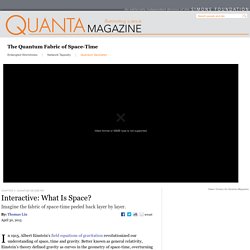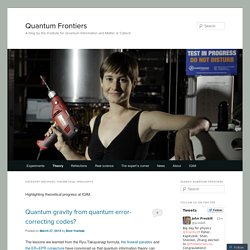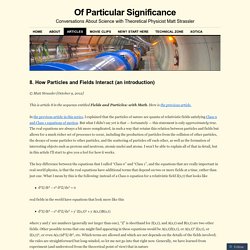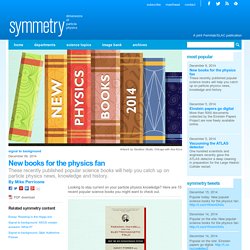

Updates on my research and expository papers, discussion of open problems, and other maths-related topics. By Terence Tao. Interactive: What Is Space? In 1915, Albert Einstein’s field equations of gravitation revolutionized our understanding of space, time and gravity.

Better known as general relativity, Einstein’s theory defined gravity as curves in the geometry of space-time, overturning Isaac Newton’s classic theory and correctly predicting the existence of black holes and gravity’s ability to bend light. But a century later, the fundamental nature of space-time remains shrouded in mystery: Where does its structure come from? What do space-time and gravity look like in the subatomic quantum realm? The short answer is that we don’t know. But many physicists, writes Jennifer Ouellette in “How Quantum Pairs Stitch Space-Time,” have long “suspected a deep connection between quantum entanglement — the ‘spooky action at a distance’ that so vexed Albert Einstein — and space-time geometry at the smallest scales.” Theoretical highlights.
The lessons we learned from the Ryu-Takayanagi formula, the firewall paradox and the ER=EPR conjecture have convinced us that quantum information theory can become a powerful tool to sharpen our understanding of various problems in high-energy physics.

But, many of the concepts utilized so far rely on entanglement entropy and its generalizations, quantities developed by Von Neumann more than 60 years ago. We live in the 21st century. Why don’t we use more modern concepts, such as the theory of quantum error-correcting codes? In a recent paper with Daniel Harlow, Fernando Pastawski and John Preskill, we have proposed a toy model of the AdS/CFT correspondence based on quantum error-correcting codes. Fernando has already written how this research project started after a fateful visit by Daniel to Caltech and John’s remarkable prediction in 1999.
This is certainly a challenging task because I need to make it accessible to everyone while explaining real physics behind the paper. Where and . . 1211.7081.pdf. Dissertation. 8. How Particles and Fields Interact (an introduction) © Matt Strassler [October 9, 2012] This is article 8 in the sequence entitled Fields and Particles: with Math.

Here is the previous article. In the previous article in this series, I explained that the particles of nature are quanta of relativistic fields satisfying Class 0 and Class 1 equations of motion. But what I didn’t say yet is that — fortunately — this statement is only approximately true. The real equations are always a bit more complicated, in such a way that retains this relation between particles and fields but allows for a much richer set of processes to occur, including the production of particles from the collision of other particles, the decays of some particles to other particles, and the scattering of particles off each other, as well as the formation of interesting objects such as protons and neutrons, atomic nuclei and atoms.
d2Z/dt2 – c2 d2Z/dx2 = 0 real fields in the world have equations that look more like this d2Z/dt2 – c2 d2Z/dx2 = y’ Z(x,t)3 + y A(x,t)B(x,t) 1. 2. New books for the physics fan. Looking to stay current on your particle physics knowledge?

Here are 10 recent popular science books you might want to check out. 1. Faraday, Maxwell and the Electromagnetic Field: How Two Men Revolutionized Physics Nancy Forbes, Basil Mahon Classical unified field theory came from the realization that electricity, magnetism and light all can be explained with a single electromagnetic field. There is no modern physics without classical unified field theory—heck, there are no electronics without classical unified field theory—and there is no classical unified field theory without Michael Faraday (1791-1867) and James Clerk Maxwell (1831-1879). The unlikely partners, born four decades apart, shared the achievement of upending a view of the world that had prevailed since Isaac Newton. 2.
Katherine Freese In The Cosmic Cocktail: Three Parts Dark Matter, physicist Katherine Freese explores the critical place dark matter occupies in our understanding of the cosmos. The year in reviews: Five books that stood out in 2014. Digital Einstein Papers Home.
Math & stuff. Edward Witten - String theory 1/5. Information Mechanics.